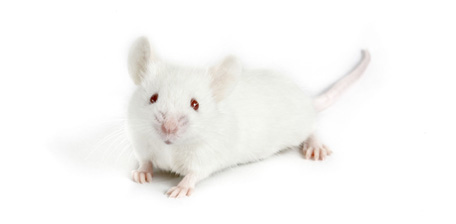The NOD.CB17-Prkdcscid/J strain (Stock Number 001303; formerly NOD/LtSz-Prkdcscid/J), a congenic JAX® GEMM® strain, is an ideal model for cancer and autoimmune disease. The strain is homozygous for a mutation in the catalytic subunit of a DNA-activated protein kinase (Prkdc) gene mutation, which arose spontaneously in a colony of BALB/c-Ighb (C.B-17) mice at the Institute for Cancer Research in Philadelphia. Because mice of this strain are defective in their ability to both repair double-stranded DNA damage and properly rearrange genes that code for antigen-specific receptors on lymphocytes, they have severe combined immune deficiency, the reason they are called scid mice. Homozygous scid mice have no functional T and B cells, have lymphopenia, hypogammaglobulinemia, and a normal hematopoietic microenvironment.
The thymus, lymph nodes, and splenic follicles of scid mice are virtually devoid of lymphocytes, and the functions of their antigen-presenting, myeloid, and natural killer (NK) cells are dependent on the strain backgrounds, which include C57BL/6J, BALB/cByJ, C3H/HeSnJSmn, and NOD/LtSz. Most scid homozygotes have no detectable IgM, IgG1, IgG2a, IgG2b, IgG3, and IgA. Some scid mice spontaneously develop partial immune reactivity. Those with serum Ig levels greater than 1 µ5g/ml are considered "leaky." Leakiness increases with age, is higher in mice housed under non-specific pathogen free conditions, and is generally high on the C57BL/6J and BALB/cByJ backgrounds, low on the C3H/HeSnJSmn background, and even lower on the NOD/LtSz background.

JAX® Mice strain NOD.CB17-Prkdcscid/J
(Stock No. 001303)
- Splenic engraftment of human CEM T-lymphoblastoid cells are four-fold greater than in the C.B-17/Sz-Prkdcscid mice.
- NK cell activity is considerably less than in C.B-17/Sz-Prkdcscid mice.
- Their macrophage populations are functionally less mature than those of C.B-17/Sz-Prkdcscid mice.
- Whereas both they and NOD/LtSz +/+ control mice lack hemolytic complement activity, the serum hemolytic complement activity of C.B-17/Sz-scid and C57BL/6Sz-scid mice is higher than that in their wildtype controls.
- Age-dependent increases in serum Ig levels (> 1 B5g/ml) were observed in only 2 of 30 NOD/LtSz-scid mice vs. 21 of 29 C.B-17/Sz-scid mice.
Because they accept allogeneic and xenogeneic grafts (respectively, grafts from the same and different species), NOD.CB17-Prkdcscid/J mice are ideal models for cell transfer experiments, such as those involving reconstitution of human hematopoietic cells; they have successfully accepted a variety of normal and malignant human cell and tissue transplants. Additionally, they may be useful for delineating the role of T cell subsets in autoimmune diabetes and as a source for insulitis-free islets. NOD.CB17-Prkdcscid/J mice are both insulitis- and diabetes-free throughout life and serve as lymphocyte-deficient and diabetes-free controls for NOD/LtJ mice (Stock Number 001976). However, they have a high incidence of thymic lymphomas, limiting their mean lifespan to 8.5 months under SPF conditions.